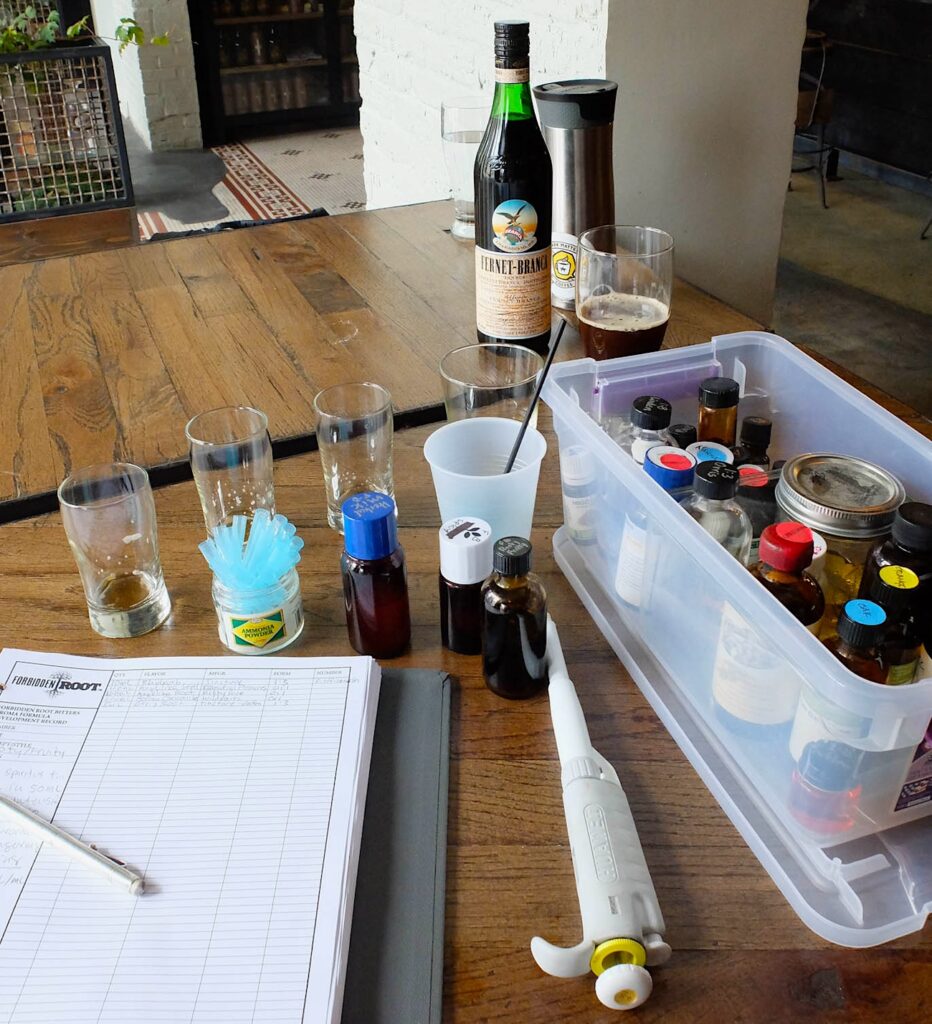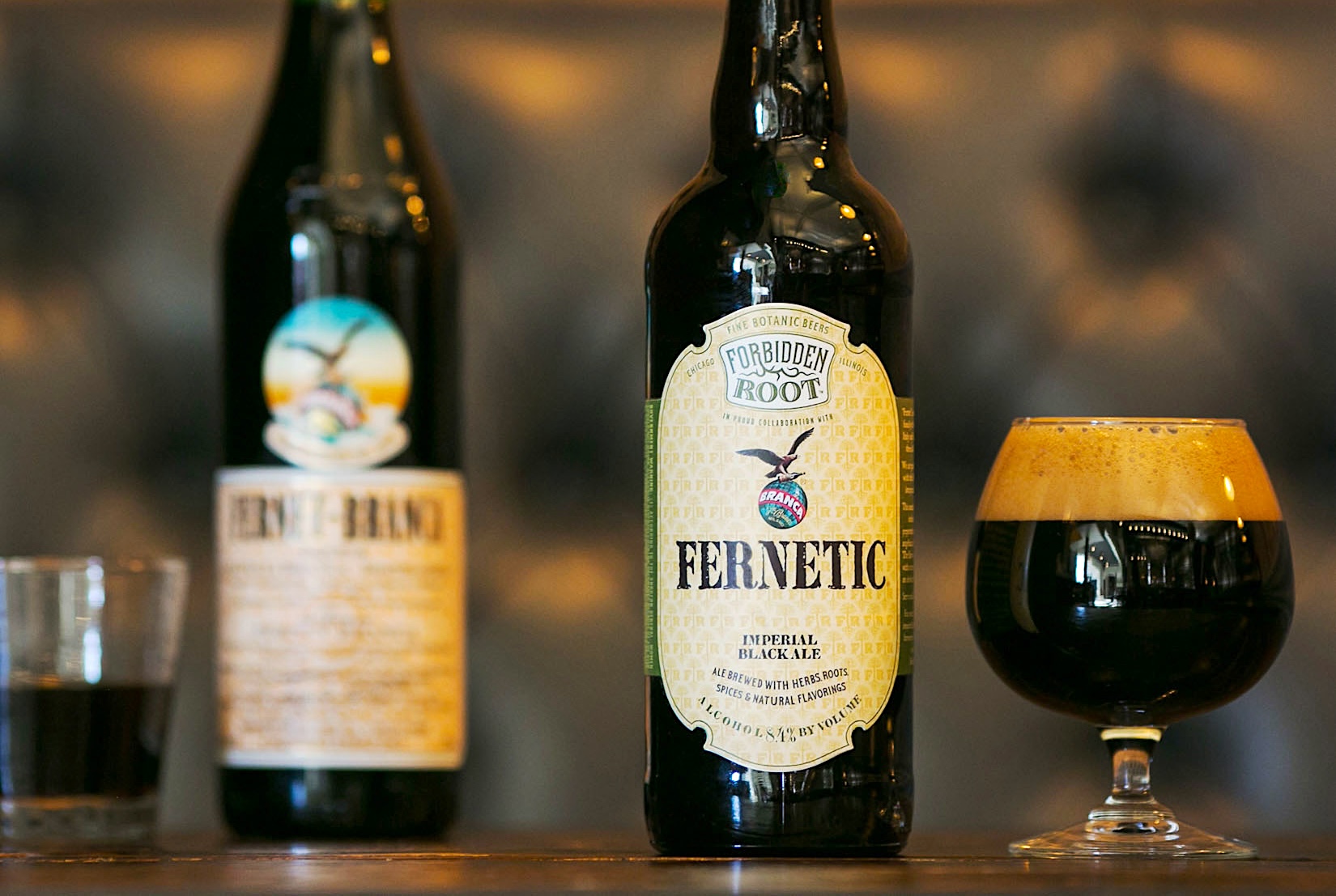© 2017, Randy Mosher / Photo (above) by BJ Pichman
We were fortunate to have a man named Edoarda Branca walk into our pub one day last spring and sample some beers. He’s a fan of good craft beer in addition to being a enthusiast and North American representative of the family’s famous products, and was impressed enough by what we’re doing at Forbidden Root to start talking about a possible collaboration with us.
Naturally, we jumped at the chance. “We’ve had lots of offers,” Branca said about other breweries that have approached them, “but we wanted to wait to work with someone professional.”
What is Fernet?
“Fernet” is a generic term for a family of bitter botanicals from Northwest Italy and nearby regions. Like its cousin, amaro, it is a holdover when the line between drink and medicine was not well defined. A fernet differs from an amaro in that it is not sweet. Fernet-Branca is the most famous of them all.
Fernet Branca is dark and intensely flavored. Peppermint is a dominant note, along with spicy and herbal notes. Saffron and cardamom add exotic aromatic notes, while linden, orris and chamomile add sweet floral overtones. A unique “rooty” note is contributed by rhubarb root, in combination with myrrh, angelica and galangal. In the mouth, it is intensely bitter with woody, tannic notes, a result of wormwood and chinchona, quite different than the bitterness found in hops. Altogether, it shows a overwhelming intensity—a window into an earlier, nearly lost era.
Goals
Our original goal was to find a way to translate the Fernet-Branca experience into beer form. There are a number of ways this could have been accomplished, but in the end we decided to be pretty direct: using malts, hops and other botanicals to create a beer with as much resemblance to Fernet-Branca as possible while retaining the drinkability and “beeriness” of the final product.
Process details
There are many lists of Fernet ingredients floating around on the Internet, and while none of them exactly match the actual drink, they mostly reflect the type of ingredients used in Fernet-Branca. The Branca family was pretty generous with us in identifying a large number of their ingredients and helping specify which ingredient was meant by some of the non-specific items on the lists. Rather than simply being protected by being locked in a safe, their secret recipe is also safeguarded by their longstanding relationships with spice and herb suppliers, and the highly specific methods of infusing raw herbs into alcohol and other bases to draw out the most desirable parts, their aging methods and of course, of the specific mix in terms of quantities.
A meeting was set to work out an approach to the recipe. After a lot of discussions between brewer BJ Pichman, managing partner and Rootmaster, Robert Finkel and myself, we devised a plan. The session followed our longstanding working method of a “blendup.” This is a rapid prototyping method that allows a lot of quick trials of both base beer and flavoring ingredients. First, commercial beers of various malt bills, strengths, bitterness and aromatic qualities are blended together to create an optimum base beer to which various flavorings can be added. It’s easy to taste a lot of ideas very quickly and make adjustments until everyone is happy. We ended up with a strongish dark beer with less roastiness than might be found in a typical stout or porter. Once you know the proportions of the specific beers that are used, it’s fairly simple matter to reconstruct a recipe for the brewhouse.
Our initial flavoring ingredient list came to 20 items. That’s an unmanageable number of permutations to sort through, so the decision was made to create blends in three groups: 1) spicy; 2) citrus/orange; 3) herbal; and 4) rooty. Peppermint, as well as the bitter herbs gentian and chinchona were added separately so their powerful effects could be controlled precisely. The flavorings were a mix of diluted essential oils, flavor extracts and calibrated tinctures made by soaking ingredients in vodka to leach out aromatic components. It’s is important that all of these contain either known quantities of aromatic oils or a specific amount of a whole herb, so calculations can be made from the final mix to scale into the pilot brew.
Trial quantities of the various ingredients were added to the selected base blend, and samples passed around. The first version seemed overly orangey and lacked rhubarb root, one of the important aroma signatures, Adjustments were made with a little additional rhubarb and a bit of oak, which we find brings flavors together, but also adds a nice, tannic final note to a beer. The second trial mix was closer, but still perhaps a little orangey, so that was dropped for the next one. A third trial hit just the right note.
After the mix was determined, calculations were done to create for a pilot brew. Brewer Pichman gave the calculated list a sanity check and dialed-back a few of the ingredients. Due to potential TTB concern about one of its components, chinchona was dropped. His first pilot turned out to hit just the right notes, a validation of the process as well as his common sense check of the recipe.
Next step, approvals. The recipe was sent to the TTB for approval, necessary for recipes containing anything not on their list of pre-approved ingredients. Because of the notorious (and some would say dubious) reputation of absinthe, wormwood is of special concern to them, particularly a chemical called thujone, so the beer was sent to their lab to measure it to ensure it remained below 10 ppm in the finished product. It passed with flying colors. Samples were also sent to Edoardo Branca, and were given an enthusiastic thumbs-up.
How’s it taste?
The final beer is dark in color and a slight, soft roastiness, pretty strong at 8.4% alc./vol. Peppermint and rhubarb root dominate the nose, along with coffee hints and an exotic, spicy complexity plus plenty of herbal notes. On the palate the flavors explode and the bitterness builds, with the unique, dry signature of wormwood and gentian, a spicy, creamy middle and a long, dry roasty and woody finish.
Glowing praise
Todd Alstrom gave Fernetic a full-page review in Beer Advocate Magazine. The score? A perfect 100. Here’s part of what he had to say: “Its herbal aromatics immediately reminded me of a fernet and were artfully layered with mint, rhubarb root, roasted malts and anise. I literally got lost in the nose. Then the creaminess of the beer and its tight carbonation lifted flavors of dried wood, earth, spice, bitter grass, medicinal tonic-like qualities, a long pepperiness, floral notes and deep cola suggestions to the forefront…I could literally see myself sipping Fernetic throughout the day.”
Below A classic in the making


